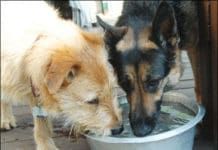Why is my dog peeing blood?
There are several conditions that can cause blood in your dog’s urine. Let’s look at the different causes and how each one is diagnosed and treated.
Is Frequent Urination in Dogs Normal?
If the symptoms your dog exhibits are straining to urinate, frequent, small accidents or repeated, small puddles when going outdoors, a likely cause is a lower urinary tract issue such as a bladder infection, bladder stones, or cystitis (bladder inflammation). Diagnostics will include a urine sample, urine culture, and possibly xrays of the bladder. Some breeds such as Schnauzers are more prone to certain lower urinary tract issues like bladder stones.
Urinary Tract Infections in Dogs
Urinary tract infections (UTIs) are one of the more common problems seen in small-animal veterinary practice. The definition of a UTI is a colonization of pathological bacteria in the normally sterile environment within the urinary tract. There are many medical conditions that make a dog prone to urinary tract infections, some of which can be prevented. Knowing how to recognize the problem is the first step to getting the proper diagnosis and treatment plan for your dog.
Canine Bladder Infections
If you've lived your life with dogs, chances are you've cared for one with a bladder infection. The normal urinary bladder is sterile, meaning devoid of bacteria. Infection occurs when bacteria find their way into the bladder and set up housekeeping. Bacterial cystitis (medical-speak for a bladder infection) is a common diagnosis in the canine world. The term urinary tract infection (UTI) is often used synonymously with bacterial cystitis. Technically speaking, a UTI can mean infection anywhere within the urinary tract, and is not specific to the bladder.
An Update on “Low Uric Acid” Dalmatians
A few months ago, I wrote about the British Kennel Club’s registration of two special Dalmatians over the objections of the breed clubs there (Whole Dog Journal June 2010). These two dogs were the result of a breeding project begun in 1973, in which a single outcross to a Pointer was made in order to reintroduce the normal gene for uric acid back into the Dalmatian bloodline.
Treatment and Prevention of Kidney and Bladder Stones
Canine kidney and bladder stones may be painful and life-threatening, but an informed caregiver can help prevent them. By far the most common uroliths or stones in dogs are struvites and calcium oxalate stones. These two types represent about 80 percent of all canine uroliths. Now we address the remaining stones that can affect our best friends: urate, cystine, calcium phosphate, silica, xanthine, and mixed or compound uroliths.
Preventing Bladder and Kidney Stones in Dogs
Bladder and kidney stones are serious problems in dogs as well as people. These conditions which are also known as uroliths or urinary calculi can be excruciatingly painful as well as potentially fatal. Fortunately, informed caregivers can do much to prevent the formation of stones and in some cases actually help treat stones that develop. Last month, we described struvite stones (see Canine Kidney Stone and Bladder Stone Prevention" Whole Dog Journal April 2010). Struvites contain magnesium
Canine Kidney Stone and Bladder Stone Prevention
just slide a clean dish under your dog as she urinates! You need to catch only a few drops to test.üUrinary tract infections that cause struvite crystals to become uroliths can raise urinary pH to 8.0 or 8.5. Contact your vet if your dog's urinary pH jumps from acid to alkaline.üStruvite (magnesium ammonium phosphate or "triple phosphate") crystals in polarized light (total magnification 112x). Struvite crystals are common in dogs and don't cause problems until they unite to form stones that interfere with urination; generally
Involuntary Urination
When my dog Popcorn woke up one morning many years ago in a puddle of urine, I panicked, certain that only a deadly illness could cause this perfectly housetrained dog to wet her bed. I rushed her to the vet, where he did a thorough physical exam and urinalysis. I can still remember the relief I felt when my vet told me it appeared to be a simple case of incontinence. As it turns out, incontinence, which is defined as involuntary urination, is quite common in dogs, especially spayed females, where about one in five dogs (20 percent) is affected.
Canine Urinalysis
Urinalysis is a screening test that may be helpful in diagnosing many diseases, but it is an especially important test to perform whenever any urinary tract disease or abnormality is expected. Abnormal appearing urine (cloudy or red colored), difficulty in urinating, abnormal frequency of urination, or abnormal flow are all indications for ordering a urinalysis.
Not Just for Sore Backs
Chiropractic treatment can solve seemingly unrelated health issues.
Permanent Markers?
Does your dog mark his territory with urine – in your house? We’ve got solutions to this icky problem.



















